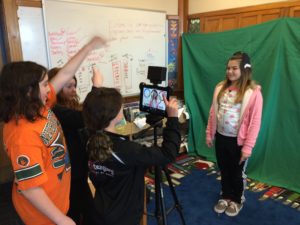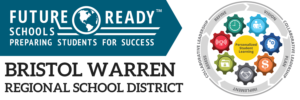Like many districts across the nation, Rhode Island’s Bristol Warren Regional School District (BWRSD) has a firm understanding of best practice and current research. However, the difficulty in scaling any innovation is converting the theory into action. To overcome this, BWRSD has adopted the Future Ready Schools® (FRS) framework, a systematic approach to scaling innovative digital learning practices while promoting long-term sustainability. This transition to digital learning affords BWRSD the opportunity to provide greater clarity and coherence regarding the district’s vision of teaching and learning. At BWRSD, we have used the opportunity to develop and communicate a new, shared vision of personalized instruction that fosters deeper learning for all students.
 Our journey began in fall 2015 with the convening of a FRS leadership team representing a cross-section of school and district leaders. (View our evolving implementation timeline here.) The team’s primary goal was to develop a shared vision for deeper learning through innovative uses of digital technologies. In January 2016, the team collectively took a district self-assessment to gauge the district’s digital learning readiness. We also engaged stakeholders across the entire district via assessment surveys conducted through the FRS dashboard, then analyzed the results along each “gear” area, exploring our strengths and weaknesses. The areas we decided to focus on first were technology infrastructure as well as curriculum, instruction, and assessment practices.
Our journey began in fall 2015 with the convening of a FRS leadership team representing a cross-section of school and district leaders. (View our evolving implementation timeline here.) The team’s primary goal was to develop a shared vision for deeper learning through innovative uses of digital technologies. In January 2016, the team collectively took a district self-assessment to gauge the district’s digital learning readiness. We also engaged stakeholders across the entire district via assessment surveys conducted through the FRS dashboard, then analyzed the results along each “gear” area, exploring our strengths and weaknesses. The areas we decided to focus on first were technology infrastructure as well as curriculum, instruction, and assessment practices.
Upgrading Infrastructure
The team quickly realized that BWRSD lacked the robust infrastructure and support systems needed to fully implement the district’s vision of personalized learning. BWRSD made several strategic investments to upgrade its network infrastructure, paving the way for 1-1 device access. We also developed a comprehensive five-year device refresh plan, implemented a new inventory and IT support system, enacted new responsible use and device policies for students and staff, and redesigned the technology department to better support the district’s FRS goals.
Digital Learning Teams
 BWRSD also committed to further supporting and expanding its Digital Learning Teams (DLTs). DLTs are comprised of 3–5 teachers in schools that were early adopters of effective technology integration. The design of BWRSD’s DLT initiative is based on the theory that “successful school reform grows from the inside out” (Elmore, 2004). These teams have assumed leadership roles in their schools, exploring emerging educational technologies, and developing models of instruction that have the power to transform teaching and learning. They have participated in extensive professional development and received onsite coaching and support throughout the year.
BWRSD also committed to further supporting and expanding its Digital Learning Teams (DLTs). DLTs are comprised of 3–5 teachers in schools that were early adopters of effective technology integration. The design of BWRSD’s DLT initiative is based on the theory that “successful school reform grows from the inside out” (Elmore, 2004). These teams have assumed leadership roles in their schools, exploring emerging educational technologies, and developing models of instruction that have the power to transform teaching and learning. They have participated in extensive professional development and received onsite coaching and support throughout the year.
To help DLT members evaluate the academic impact of their new strategies, they developed and conducted a series of short-cycle action research projects. These 6–8 week cycles focused on improving a particular student skill/competency, during which the teacher chose a blended-learning instructional model along with a set of digital learning tools/resources. Since the goal of the action research was discovery, it was ok if a particular project was not as successful as hoped. A “failed” project still proved a success since we learned not to further devote time and resources to that particular strategy and edtech tool. On the other hand, successful action research projects moved to the next phase of iteration and scaling across the school and district.
When teachers are empowered to take risks and make changes related to teaching and learning, student achievement is enhanced (Marks and Louis, 1997; Sweetland and Hoy, 2002), and schools become more effective learning communities (Detert, Louis, and Schroeder, 2001). The outcome of DLT action research has been shared with colleagues at faculty meetings, during peer walkthroughs, at community technology nights, and even showcased at school committee meetings. For School Year 2016–17, the team expanded to thirty-three members across six schools representing various grade levels and areas of expertise.
Scaling Innovation
 To further support BWRSD’s vision, the FRS leadership team is expanding to include a greater cross-section of the district, while also splitting into gear-level teams to implement the action plan in each school. We are also developing a comprehensive communications plan through a new district FRS website, Youtube channel, and social media campaign (#BWRSD) to reach all district stakeholders to articulate our goals, monitor progress and celebrate successes. BWRSD’s administration team also conducted a crosswalk of its FRS plan with the district’s newly adopted strategic plan, along with other initiatives underway that align with and support FRS. This provided clarity and coherence regarding what are, at times, seen as competing initiatives, yet are actually integral pieces of the district’s larger goal to become Future Ready.
To further support BWRSD’s vision, the FRS leadership team is expanding to include a greater cross-section of the district, while also splitting into gear-level teams to implement the action plan in each school. We are also developing a comprehensive communications plan through a new district FRS website, Youtube channel, and social media campaign (#BWRSD) to reach all district stakeholders to articulate our goals, monitor progress and celebrate successes. BWRSD’s administration team also conducted a crosswalk of its FRS plan with the district’s newly adopted strategic plan, along with other initiatives underway that align with and support FRS. This provided clarity and coherence regarding what are, at times, seen as competing initiatives, yet are actually integral pieces of the district’s larger goal to become Future Ready.
Along with the focus on leadership and communications and the expansion of the digital learning team, the district also is making strategic investments in digital devices across the district that best align with the instructional goals and learning needs of each grade level. To further support this, we are actively conducting pilots of digital learning tools, such as WeVideo Edu, that can support the district’s path toward personalization and deeper learning for all students. This is all part of developing a robust digital learning ecosystem that supports innovating teaching and learning for students across the district. With a focus on student learning, strategic use of the gear framework, and strong collaborative leadership, BWRSD is on the path to being a world-class, Future Ready school district.
About the Authors
 Dr. Mario Andrade, EdD, is an educational practitioner who has more than nineteen years of experience in private and public education. Dr. Andrade has held a variety of administrative positions in public education, including assistant principal at Newport Public Schools; principal at Central Falls Public Schools; assistant superintendent for curriculum, instruction, and assessment for BWRSD. Currently, he is superintendent of BWRSD. Dr. Andrade possesses extensive leadership and staff development experience in the areas of professional learning communities as well as curriculum mapping related to the Common Core State Standards and Next-Generation Science Standards. He utilizes this knowledge as a foundation for training and developing good pedagogical skills amongst his teaching staff. Dr. Andrade has a doctorate degree in educational leadership from Johnson & Wales University, a master of science degree in special education from Simmons College, and a bachelor of arts degree from the University of Connecticut. Follow Dr. Andrade on twitter at @MarioJAndrade.
Dr. Mario Andrade, EdD, is an educational practitioner who has more than nineteen years of experience in private and public education. Dr. Andrade has held a variety of administrative positions in public education, including assistant principal at Newport Public Schools; principal at Central Falls Public Schools; assistant superintendent for curriculum, instruction, and assessment for BWRSD. Currently, he is superintendent of BWRSD. Dr. Andrade possesses extensive leadership and staff development experience in the areas of professional learning communities as well as curriculum mapping related to the Common Core State Standards and Next-Generation Science Standards. He utilizes this knowledge as a foundation for training and developing good pedagogical skills amongst his teaching staff. Dr. Andrade has a doctorate degree in educational leadership from Johnson & Wales University, a master of science degree in special education from Simmons College, and a bachelor of arts degree from the University of Connecticut. Follow Dr. Andrade on twitter at @MarioJAndrade.
 Tom Driscoll is director of educational technology for BWRSD. Previously, Mr. Driscoll taught high school social studies in Connecticut while also regularly speaking at conferences and consulting with school districts across the nation. He has also authored chapters for several books on instructional technology including “Flipped Learning: Gateway to Student Engagement” and “Flipping 2.0.” Tom has a Master’s Degree in Computing in Education from Teachers College, Columbia University and continues to research how innovative applications of emerging technologies can fundamentally transform teaching and personalize student learning. Follow Mr. Driscoll on twitter at @Mr_Driscoll.
Tom Driscoll is director of educational technology for BWRSD. Previously, Mr. Driscoll taught high school social studies in Connecticut while also regularly speaking at conferences and consulting with school districts across the nation. He has also authored chapters for several books on instructional technology including “Flipped Learning: Gateway to Student Engagement” and “Flipping 2.0.” Tom has a Master’s Degree in Computing in Education from Teachers College, Columbia University and continues to research how innovative applications of emerging technologies can fundamentally transform teaching and personalize student learning. Follow Mr. Driscoll on twitter at @Mr_Driscoll.

